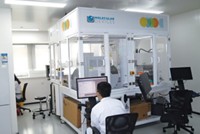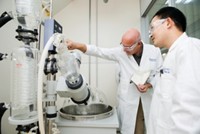Advertisement
Grab your lab coat. Let's get started
Welcome!
Welcome!
Create an account below to get 6 C&EN articles per month, receive newsletters and more - all free.
It seems this is your first time logging in online. Please enter the following information to continue.
As an ACS member you automatically get access to this site. All we need is few more details to create your reading experience.
Not you? Sign in with a different account.
Not you? Sign in with a different account.
ERROR 1
ERROR 1
ERROR 2
ERROR 2
ERROR 2
ERROR 2
ERROR 2
Password and Confirm password must match.
If you have an ACS member number, please enter it here so we can link this account to your membership. (optional)
ERROR 2
ACS values your privacy. By submitting your information, you are gaining access to C&EN and subscribing to our weekly newsletter. We use the information you provide to make your reading experience better, and we will never sell your data to third party members.
Business
R&D Shapes Up At HEC Pharm
Chinese newcomer sticks to ambitious plan to become an innovative drug firm
by Jean-François Tremblay
February 27, 2012
| A version of this story appeared in
Volume 90, Issue 9
At the rate it is hiring people and investing in its R&D infrastructure, it shouldn’t be long before China’s HEC Pharm becomes as well-known as India’s Ranbaxy Laboratories or Dr. Reddy’s Laboratories. This obscure generic drug maker, with headquarters in the gritty industrial city of Dongguan in southern China, aims to launch innovative new drugs in China and, eventually, in the U.S., Europe, and other developed markets.
At its R&D complex, the company has more than doubled its technical workforce during the past year to 1,200 researchers, most of whom live in company-provided housing. It is completing construction of two new buildings that will house biology labs and research facilities for clean energy materials that will be developed mostly by the firm’s chemists. And within a few months, it will break ground on a 21-floor apartment complex to house new hires and on a 12-floor research lab for new-drug R&D. In May 2011 HEC completed construction of its generic drug labs.
“Developing new drugs remains our priority,” says Xinfa (Richard) Tang, director of HEC’s R&D center. “We want to become known as an innovative drug company.” The company’s R&D efforts are led by about 30 senior Chinese and foreign scientists with experience in the international drug industry.
Hiring qualified researchers is a big part of HEC’s strategy. To fill its technical positions, it recruits by offering competitive salaries, family housing, subsidized meals, and other benefits. Fresh Ph.D. graduates get a starting salary of $24,000 and regular raises—a good wage by Chinese standards, says Tommy Lin, HEC’s director of intellectual property. The company hopes to employ 2,500 researchers within three years.

It may appear foolhardy for a newcomer in the field of drug R&D to be so ambitious. But in fact, HEC is following a carefully conceived plan (C&EN, Feb. 28, 2011, page 40).
The plan is based on the company’s sound financial condition. Despite all the money it is pouring into its R&D capabilities, HEC is generating cash, Tang says. An established supplier of active pharmaceutical ingredients and finished generic drugs mostly for China, the firm reported sales of $475 million in 2010. In Hubei province, in east central China, it operates the world’s largest plant for the antibiotic erythromycin. Further buttressing HEC’s financial resources is its parent company, HEC Group, a conglomerate whose main business is aluminum.
HEC Pharm’s managers acknowledge that it will take years before they can launch innovative drugs in regulated markets. For now, the firm plans to introduce generic drugs in the U.S. and Europe. It just secured U.S. Food & Drug Administration approval to sell, under its own name, the antiretroviral drug zidovudine, commonly known as AZT. In Europe, it has been cleared to sell the macrolide antibiotic azithromycin. That approval marks HEC as the first Chinese company to sell a drug under its own name in Europe, Lin claims.
It’s not as hard as it once was for a Chinese company to sell drugs in developed markets, Tang notes. Despite some well-publicized quality problems—the heparin scandal of 2008 being the most prominent—the image of Chinese drugs in developed countries has on the whole improved in the past decade, Tang says. More important, European governments are trying to contain health care costs, and buying drugs from China is one way to do it.
Before launching new drugs in developed markets, HEC plans to introduce them in China, Tang adds. Winning approval for a new drug in China is simpler than in the U.S., because in China a new drug does not have to be superior to an existing one.
The firm is pursuing cardiovascular, antiviral, antitumor, and neurological compounds. It has obtained regulatory approval to start clinical trials in China for morphothiadine mesilate, a treatment for hepatitis B virus that was discovered, and later dropped, by Bayer.
HEC isn’t the only company seeking to discover new drugs in China, says Greg B. Scott, president of ChinaBio, a Shanghai-based company that advises investors in China’s biotech sector. In Beijing, he notes, the start-up BeiGene is building oncology labs. In Hangzhou, another start-up, Ascletis, has raised $100 million to build drug discovery labs. And Aslan Pharmaceuticals, a Singapore-based biotech firm, conducts most of its research in China.
But Scott questions whether new drugs without significantly improved efficacy will succeed in China. “If a drug isn’t superior to what’s already on the market, why would a patient buy it?” he asks. Moreover, drugs launched in China are at risk of being subject to price controls, he says. China recently more than tripled its list of price-controlled “essential drugs,” he points out.
It’s too early to tell whether HEC’s vast investment in pharmaceutical R&D will eventually pay off. What is unquestionable is that the firm is making rapid progress in establishing an impressive R&D infrastructure.




Join the conversation
Contact the reporter
Submit a Letter to the Editor for publication
Engage with us on Twitter